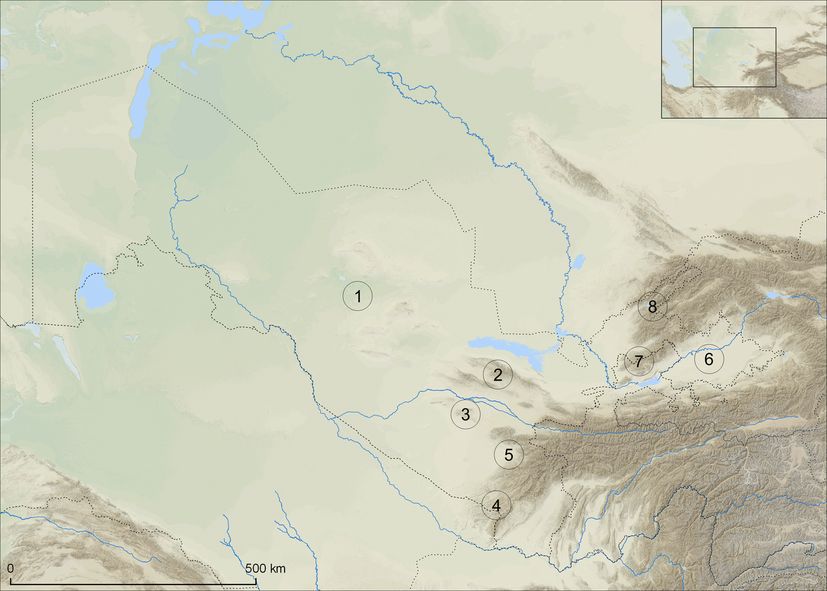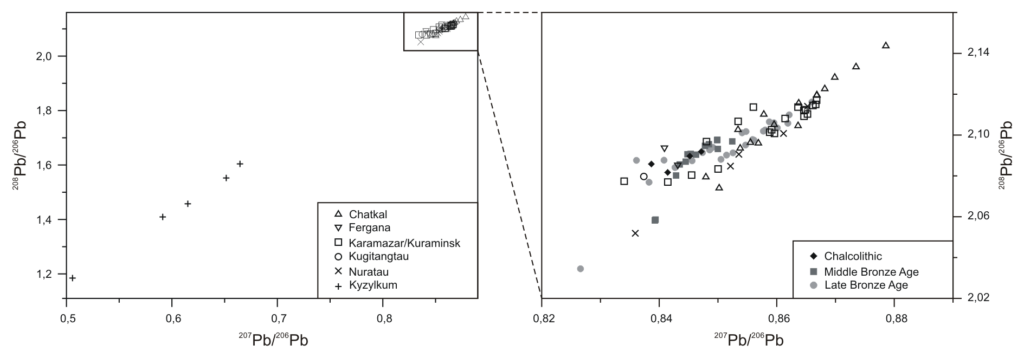Prehistoric Mining and Metallurgy in Uzbekistan
The copper deposits investigated in the project are distributed over eight different mining centres.
- Runtime: 01.08.2016 - 31.07.2020
- Supporter: Deutsche Forschungsgemeinschaft
- Partner: Geological Museum of Uzbekistan and German Archaeological Institute
The earliest metal finds in Central Asia date the beginning of metalworking to the 6th/5th millennium BC. Often the Central Asian copper deposits and in particular those of Uzbekistan are mentioned as raw material sources, but without substantiating this with geochemical data. Investigations into pre- and protohistoric mining in Uzbekistan and adjacent regions were mainly carried out during exploration activities of the Soviet Union in the first half of the 20th century. However, the main focus was on mapping the ore deposits for possible industrial exploitation.
Participants: PD Dr. N. Boroffka (DAI); A. Sh. Ahmedshaev, H. Saipov (Geological Museum Tashkent); Dr. Sh. R. Pidaev, Dr. L. M. Sverchkov (Academy of Sciences of Uzbekistan)
Therefore the description and documentation of ancient mining sites during those activities was predominantly performed by geologists and only occasionally by archaeologists. Also, systematic excavations in the mining areas were rarely carried out, and if, then usually at medieval sites that were already known from written sources. Prehistoric mining always played a minor role in the previous (Russian/Soviet) investigations, which is why only a rough description of the extent of Central Asian copper ore deposits and their significance in prehistoric times can be found in the literature. Therefore, only little information about the beginning of the exploitation of copper bearing deposits is available.
On the other hand, the traces of prehistoric mining, especially in Uzbekistan, are often destroyed or covered by medieval and modern mining activities, for which reason the prehistoric exploitation of deposits can only be proven on basis of an analytical approach. Geochemical data are already available for the copper deposits of the Iranian highland or the Caucasus, but there exist practically no geochemical characterisation for the copper deposits of Uzbekistan. Only since the middle of the 1990s more research on the origin of raw materials and their distribution has been carried out in Central Asia and the adjacent regions. The focus of this new research, however, is mainly on the origin of tin and gold, while the origin of Central Asian copper still remains highly hypothetical.
Therefore the primary aim of the project “PMU: Prehistoric Mining and Metallurgy in Uzbekistan” (funded by the German Research Foundation, KR 4876/1-1) is, based on selective surveys and sampling of the ore deposits, the establishment of a data basis in order to investigate the potential of the Uzbek copper deposits in terms of their prehistoric exploitation.
For this purpose, copper ores from various deposits in Uzbekistan are being analysed at CEZA with regard to their geochemical and lead isotopic composition. Another focus of the project is on the analysis of archaeological metal finds from Central Asia. Based on the conjunction of the chronological classification of the objects between the Chalcolithic and the Early Iron Age and the detailed geochemical characterisation of the ore deposits new knowledge about the prehistoric use of resources and their distribution over time is expected placing the importance of the copper ore deposits of Uzbekistan as suppliers of raw materials in a wider context.
Report
Research area

The copper deposits investigated in the project are distributed over eight different mining centres (Figure 1): the Kyzylkum Desert, the Nuratau Mountains, the Zirabulak/Ziyadin Mountains, the Kugitangtau Mountains, the Kyzyldarya Valley, the Fergana Valley as well as the Karamazar/Kuraminsk Mountains and the Chatkal Mountains. Some of the ores examined were collected during field surveys, while the largest number of samples were provided by the Geological Museum of the State Committee of the Republic of Uzbekistan for Geology and Mineral Resources in Tashkent. In total about 140 samples from more than 50 different copper ore deposits were selected for the investigations. Unfortunately, it was not possible to take representative samples from all deposits, but even the results of their analysis will help to get a first idea of the possible use of those deposits in prehistoric times.
Preliminary results
The scientific examination of the ore samples includes the determination of their mineralogical composition using light and scanning electron microscopic methods and their chemical composition using wavelength dispersive X-ray fluorescence analysis (WD-XRF) as well as the determination of their lead isotope ratios using a multi-collector mass spectrometer with inductively coupled plasma (MC-ICP-MS). In addition, some selected ore samples from the most important deposits were analysed by neutron activation analysis (NAA) for their trace element contents.
Based on the mineralogical investigations most ores contain typical oxidic as well as sulfidic ore minerals. The most frequent oxidic ore minerals are malachite (often associated with cuprite), azurite, brochantite and atacamite. Among the sulphide minerals, chalcopyrite together with pyrite and chalcocite dominate. But also, native copper appears in some deposits, as it is known from Dal’nee in the Karamazar/Kuraminsk Mountains and from Naukat in the Fergana Valley.
The results of the geochemical analyses show that the composition is often determined by the surrounding rock. Depending on the (ore) mineral content, type and grade of mineralisation, the samples show more or less significantly different trace element patterns. However, the majority of the investigated samples have element contents that were not detected by WD-XRF. Furthermore, some samples cannot be directly considered as potential ores due to their rather low copper content. But they characterise the respective deposits by their lead isotope ratios.

The diagrams in figure 2 give a first impression of the results of the lead isotope analysis. Comparing them with data from metal artefacts of different time periods it becomes apparent, that most of the ores from the Kyzylkum were not used in prehistoric times due to their high contents of radiogenic lead. On the other hand, some samples were not suitable for isotope analyses due to their too low lead content. This especially concerns the samples from the Bukantau Mountains, where numerous traces of old mining already indicate prehistoric exploitation of the deposits.
Furthermore, the analyses show that the beginning of the exploitation of the Central Asian deposits can be assumed as early as the Chalcolithic, at the latest in the Middle Bronze Age. Especially the copper deposits of the Karamazar/Kuraminsk and Chatkal mountains seem to have been of great importance over a long period of time (up to the Middle Ages), even though other raw material deposits were also exploited in the further course of the Bronze Age. Although it is not yet possible to identify individual deposits as raw material suppliers for specific sites, the potential of the Central Asian deposits was undoubtedly known since the Middle Bronze Age and was of greater importance in the Late Bronze Age.
Summary and perspectives
The results of the project “PMU: Prehistoric Mining and Metallurgy in Uzbekistan”, funded by the German Research Foundation (DFG), can only be presented here in excerpts. They provide a first comprehensive data basis for for geoarchaeological provenance investigations also beyond the scope of the project. It was shown that the Central Asian copper ore deposits were probably since the Chalcolithic, but at latest since the beginning of the Bronze Age. On the other hand, it became apparent that the is not yet sufficient data for a direct identification of copper deposits as a supplier of raw materials for certain archaeological sites and further investigations are necessary. Therefore it is planned to analyse more samples from deposits that have not been analysed representatively so far in order to extend the existing data basis. In this context, further chemical and isotope analyses will be carried out on archaeological metal objects from the Chalcolithic to the Early Iron Age in order to gain a better understanding of the use of the deposits during the different periods.
Literatur
Kraus, S., 2018, Prähistorischer Bergbau und Metallurgie in Usbekistan – Erste Ergebnisse, in: Glaser, L. (Hrsg.), Archäometrie und Denkmalpflege 2018, DESY-PROC, Verlag Deutsches Elektronen-Synchrotron, Hamburg, 79-82.
Kraus, S., 2020, Prehistoric Mining and Metallurgy in Uzbekistan: An Introduction, in: Otto, A.; Herles, M.; Kaniuth, K.; Korn, L. & Heidenreich, A. (eds.), Proceedings of the 11th International Congress on the Archaeology of the Ancient Near East 03-07 April 2018, Munich. Volume 2: Field Reports, Islamic Archaeology, Harrassowitz Verlag, Wiesbaden, 197-206.
Kraus, S.; Schifer, T. & Pernicka, E., in preparation, The Archaeometallurgical Studies of the ROXIANA-Project, in: Boroffka, N. & Francfort, H.-P. (eds.), The ROXIANA-Project (working title)